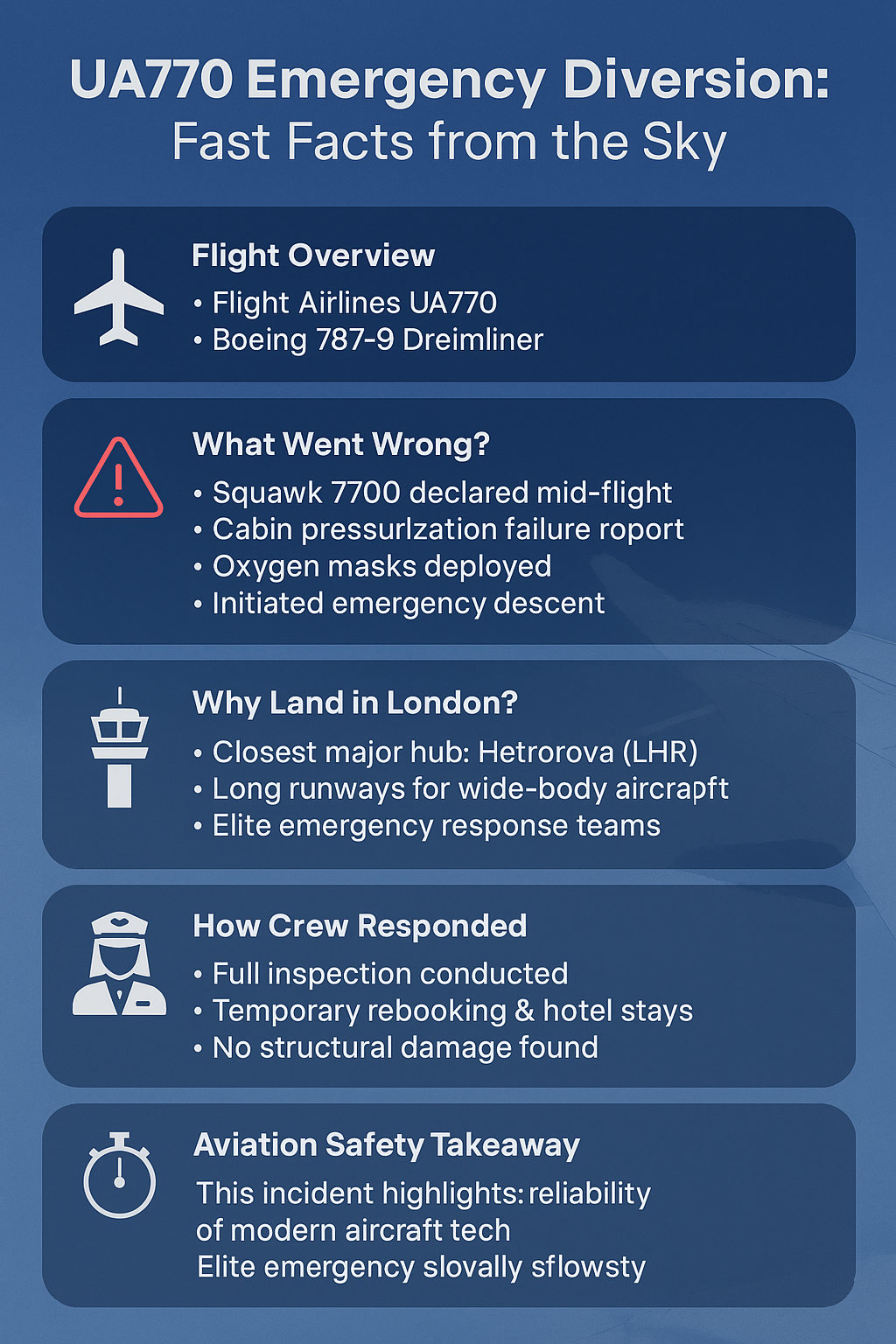✈️ Overview of the UA770 Emergency Diversion
On May 27, 2025, United Airlines Flight UA770, a Boeing 787-9 Dreamliner, was en route from Barcelona (BCN) to Chicago O’Hare (ORD) when it made an emergency diversion to London Heathrow (LHR). The incident triggered a Squawk 7700, the universal transponder code for a general emergency, prompting immediate response from air traffic control and emergency services.

🚨 What Is Squawk 7700 and Why Was It Used?
🛑 Meaning of Squawk 7700
When pilots enter Squawk 7700 into the aircraft’s transponder, it alerts all nearby air traffic control centers that the aircraft is experiencing an emergency. This code overrides all other transponder signals and gives the flight priority handling.
⚠️ Why UA770 Declared an Emergency
Reports indicate that the aircraft experienced a cabin pressurization issue, causing oxygen masks to deploy. Passengers described hearing strange noises followed by a controlled but rapid descent. The crew acted swiftly, initiating emergency protocols and rerouting the flight to the nearest suitable airport.
🛬 Why London Heathrow Was Chosen for Diversion
📍 Strategic Location and Infrastructure
Heathrow Airport was selected due to its:
- Proximity to the aircraft’s position over Europe
- Long runways suitable for wide-body aircraft
- Advanced emergency response capabilities
🤝 Seamless Coordination
EUROCONTROL and British ATC worked together to clear a priority flight path. Within 30 minutes of the emergency declaration, UA770 was safely on final approach to Runway 27R at Heathrow.
👨✈️ Crew Response and Aircraft Systems
🧠 Boeing 787-9 Safety Features
The Dreamliner is equipped with:
- Triple-redundant flight control systems
- Airplane Health Management (AHM) monitoring over 280,000 parameters
- Fly-by-wire emergency modes for simplified control
These systems helped the crew maintain control and make informed decisions during the emergency.
👩✈️ Calm and Professional Crew Actions
The flight crew:
- Declared the emergency promptly
- Communicated clearly with passengers
- Coordinated with ground control for a safe landing
Cabin crew ensured all passengers were seated, secured, and informed throughout the descent.
👥 Passenger Experience During the Diversion
😨 In-Flight Reactions
Passengers reported:
- Deployment of oxygen masks
- Sudden descent that felt alarming
- Confusion due to limited initial information
Despite the tension, many praised the professionalism and calm demeanor of the crew.
🙌 Post-Landing Support
After landing, United Airlines provided:
- Medical evaluations for affected passengers
- Hotel accommodations and meal vouchers
- Rebooking assistance for missed connections
🔍 Post-Incident Inspection and Safety Review
🔧 Aircraft Evaluation
United’s maintenance team, along with Heathrow’s emergency services, conducted a full inspection of the aircraft. Preliminary findings pointed to a pressurization system fault, though no structural damage was reported.
🛡️ Regulatory Oversight
Authorities including the FAA and EASA were notified. A formal investigation was launched to determine the root cause and ensure compliance with safety standards.
📊 What This Incident Teaches Us About Aviation Safety
🧪 The Role of Technology
Modern aircraft like the Boeing 787-9 are designed to:
- Detect anomalies early
- Provide real-time diagnostics
- Support pilots with automated safety protocols
🧑✈️ Training and Preparedness
This event highlights the importance of:
- Regular emergency drills for flight crews
- International coordination between air traffic agencies
- Transparent communication with passengers
✅ Conclusion: A Successful Emergency Response
The United Airlines Flight UA770 emergency diversion is a textbook example of how advanced technology, skilled crews, and global coordination can turn a potential disaster into a safe outcome. While the experience was unsettling for passengers, the swift and effective response ensured that everyone landed safely.




















